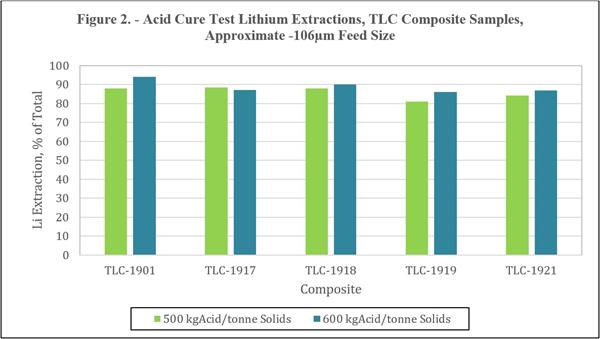Jun 18 2020
American Lithium Corp., a pioneering lithium exploration and development company, announced promising results from testing to simplify the lithium extraction process from the sedimentary claystone deposits of its 100% owned TLC lithium claystone discovery close to Tonopah, Nevada.
 Acid cure test lithium extractions, TLC composite samples, approximate – 106 µm feed size. Image Credit: American Lithium Corp.
Acid cure test lithium extractions, TLC composite samples, approximate – 106 µm feed size. Image Credit: American Lithium Corp.
Designed by SND Consulting of Tucson, Arizona, and performed by McClelland Laboratories of Sparks, Nevada, the testing shows that the use of an acid agglomeration and cure process to extract lithium led to 87% lithium extraction on average, with only a brief agitation period and without the need for high-solution temperature requirements.
As a follow-up to the news release from American Lithium dated May 5th, 2020, which elucidated early testing results of various extraction methods, the company reports that continued work points to higher success in the use of acid agglomeration and cure technique.
Although TLC lithium claystone is highly leachable consistently all through the project, the latest testing shows that it is possible to complete the extraction process without using any heat and within a short agitation time.
Moreover, acid consumption was found to be lower than what is needed for an agitation leach. No statistical differences were found in lithium extractions between acid dose levels of 500 or 600 kg/tonne of ore, which indicates that it is essential to evaluate lower acid dose to define the lower limit.
Our excitement with TLC continues to build as the project gets further de-risked at every stage. American Lithium has demonstrated that by using relatively large amounts of acid, all the lithium in the TLC resource is highly leachable using simple processes. Now that the upper bound has been established, we are optimizing to determine the lower bound of acid consumption.
Michael Kobler, CEO, American Lithium Corp.
Kobler continued, “We are excited about the acid agglomeration and curing process due to the potential for lower acid consumption and the fact that heating and heavy agitation is not required.”
Despite potentially using a little more acid, the cost of acid is offset by the higher lithium recovery and overall simplicity of the process. The real cost of acid is in the cost of neutralization of that acid, and TLC has the huge advantage of locally available, low cost neutralization agents for the neutralization of the leachate and the precipitation of deleterious elements.
Michael Kobler, CEO, American Lithium Corp.
“This makes us less sensitive to the cost of acid, although we still strive to economically minimize its use. As a result, we are not concerned about leaching co-minerals due to our cost effective and simple processes to remove them,” added Kobler.
After these successes, American Lithium has employed McClelland Labs to conduct the subsequent testing series, which includes the assessment of the following: neutralization of solutions, volume reduction, precipitation of magnesium, precipitation of calcium, and finally precipitation of lithium.
The ultimate goal of this series is to create a battery-grade lithium product at a bench scale. Furthermore, McClelland Labs is being employed to start testing of acid consumption optimization with the expectation of considerable reductions in acid requirements.
Acid Cure Testing
Sulfuric acid cure tests were performed on composite samples of assay pulp material obtained from five different drill holes on the TLC project (composite grades: 1,060 to 1,270 ppm Li). Agglomeration of a 0.5-kg sample was performed with concentrated sulfuric acid and water for each of these tests.
The agglomerates were left to cure for 24 hours before they were slurried in water (and agitated for about 5 minutes), filtered, and washed to extract dissolved lithium. Both curing and washing were performed at ambient temperature. Lithium extractions of 80.9% to 88.5% were realized by following these procedures, by adding agglomeration sulfuric acid at the rate of 500 kg/tonne.